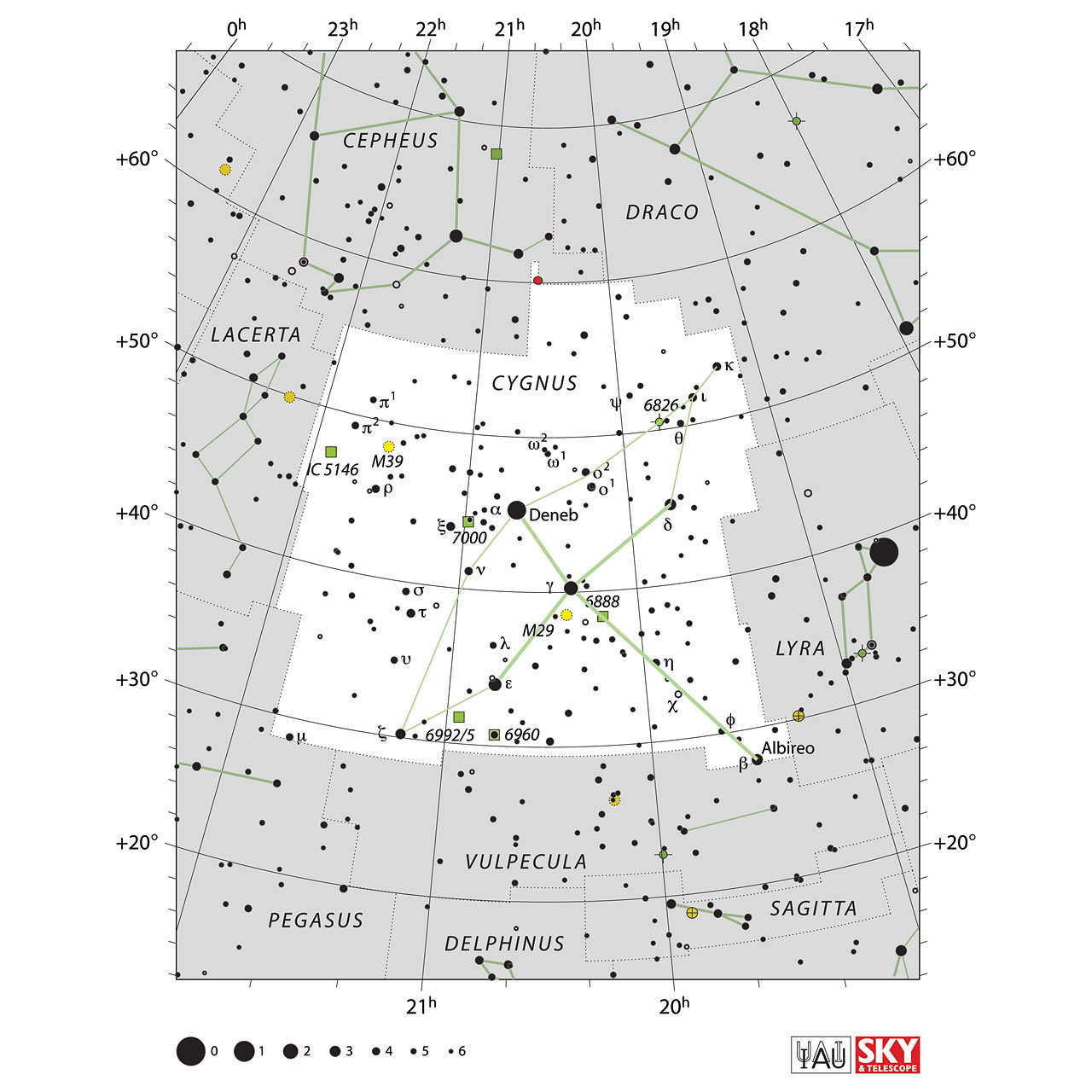Cygnus


Cygnus is a large and easily recognisable constellation in the northern summer sky. Its brightest star, Deneb forms one vertex of the Summer Triangle asterism. Cygnus was among the 48 constellations listed by the 2nd century astronomer Ptolemy
Visually, Cygnus appears as a ‘T’-shaped grouping of stars, with a fainter star Albireo (β¹-Cyg) making the T into a cross. For this reason, the asterism is sometimes known as the Northern Cross.
The Milky Way passes through the middle of the cross, littering it with some of the richest star fields in the northern sky. Among these are twenty open clusters of tenth magnitude or brighter. A pair of binoculars are quite sufficient to bring hundreds of stars into view.
The star Albireo (β¹-Cyg) is particularly often observed, as it is a binary whose two components have two strongly contrasting colors – one red and the other blue.
The name ‘Cygnus’ is Latin for ‘swan’, though accounts vary as to the swan’s identity. In one popular story, Cygnus is the god Zeus in disguise, pursuing one of his many love interests – perhaps Nemesis or Leda, mother of Helen of Troy.
One story based in Greek mythology told of two close friends, Cygnus and Phaeton, who were continually competing. One day, they each challenged the other to a race across the sky, around the Sun, and back to Earth. In an effort to gain the advantage, they both cut too closely to the Sun and their chariots were burned up. They both fell to the Earth and were knocked unconscious. Upon recovering, Cygnus began looking for his friend, Phaeton, and discovered his body trapped by the roots of a tree at the bottom of the Eridanus River. In an effort to retrieve his friend’s body and give it a proper burial, Cygnus repeatedly dove into the river, but could not reach his friend’s body. While he sat grieving on the bank of the river, Cygnus begged for Zeus to help him. Zeus replied that if he gave Cygnus the body of a swan, he would be able to dive deeply enough to retrieve his friend’s body. However, if Cygnus did take on the body of a swan, he would also be giving up his immortality and would only live as long as a swan would normally live. Cygnus readily agreed to this in order to retrieve his friend’s body and give him a proper burial, allowing his friend’s spirit to travel into the afterlife. In honor of this great unselfish act, Zeus placed Cygnus’ image (that of a swan) into the night sky.
In the Indian names given to constellations, Cygnus is called ರಾಜ ಹಂಸ (Raja Hamsa)
Cygnus contains:
-
Stars
- Deneb (mag 1.3)
- Sadr (mag 2.2)
- ε-Cyg (mag 2.5)
- δ-Cyg (mag 2.9)
- Albireo (mag 3.1)
- ζ-Cyg (mag 3.2)
- ξ-Cyg (mag 3.7)
- τ-Cyg (mag 3.7)
- ι-Cyg (mag 3.8)
- κ-Cyg (mag 3.8)
- V695 Cyg (mag 3.8)
- η-Cyg (mag 3.9)
- ν-Cyg (mag 3.9)
- ρ-Cyg (mag 4.0)
- V1488 Cyg (mag 4.0)
- 41-Cyg (mag 4.0)
- 52-Cyg (mag 4.2)
- σ-Cyg (mag 4.2)
- π²-Cyg (mag 4.2)
- 33-Cyg (mag 4.3)
- υ-Cyg (mag 4.4)
- 39-Cyg (mag 4.4)
- θ-Cyg (mag 4.5)
- f²-Cyg (mag 4.5)
- λ-Cyg (mag 4.6)
-
Open Clusters
- Messier 39 (mag 4.6)
- NGC 6871 (mag 5.2)
- Messier 29 (mag 6.6)
- NGC 6811 (mag 6.8)
- NGC 7063 (mag 7.0)
- NGC 7082 (mag 7.2)
- IC 4996 (mag 7.3)
- NGC 6819 (mag 7.3)
- NGC 6910 (mag 7.4)
- NGC 7039 (mag 7.6)
- NGC 6866 (mag 7.6)
- NGC 6834 (mag 7.8)
- NGC 6883 (mag 8.0)
- NGC 7062 (mag 8.3)
- NGC 7086 (mag 8.4)
- IC 1369 (mag 8.8)
- NGC 7031 (mag 9.1)
- NGC 7128 (mag 9.7)
- NGC 7067 (mag 9.7)
- IC 5146 (mag 10.0)
- NGC 6997 (mag 10.0)
- NGC 6996 (mag 10.0)
- NGC 7044 (mag 12.0)
- IC 1311 (mag 13.1)
- NGC 6846 (mag 14.2)
-
Globular ClustersNone
-
Galaxy
View Cygnus in 3D 
Source: Wikipedia, in-the-sky.org
Image Courtesy: Sky&Telescope & IAU, Illustration Images linked from Urania's Mirror on Wikmedia Commons by Sidney Hall
Image Courtesy: Sky&Telescope & IAU, Illustration Images linked from Urania's Mirror on Wikmedia Commons by Sidney Hall
